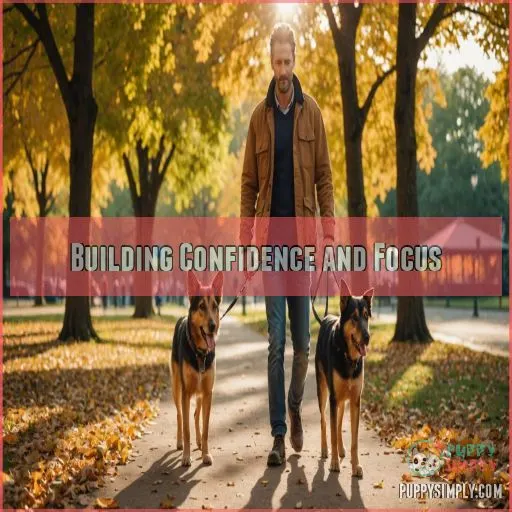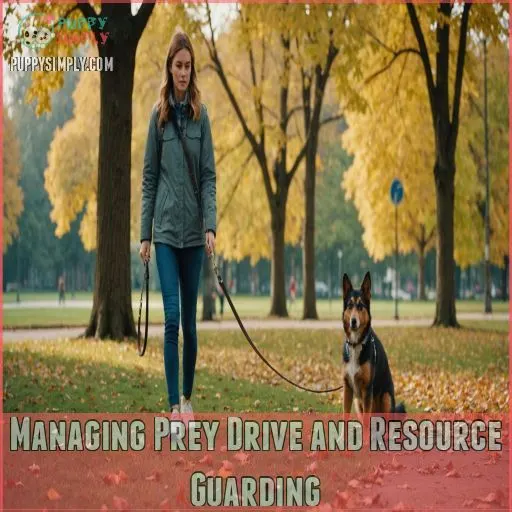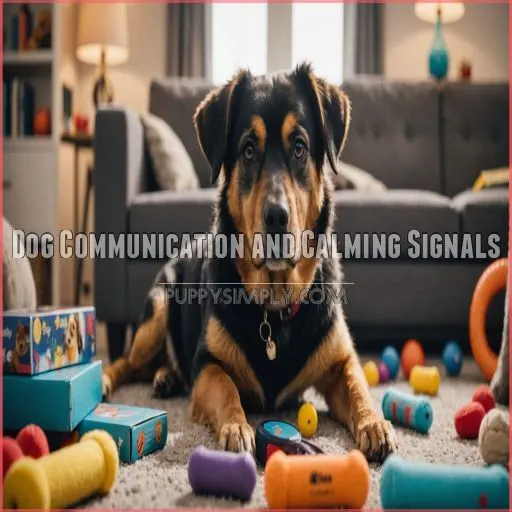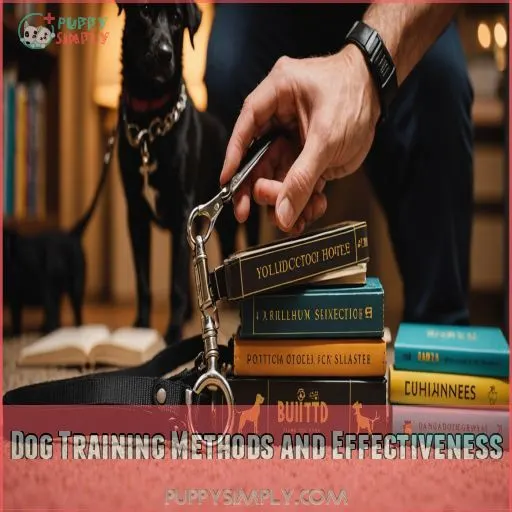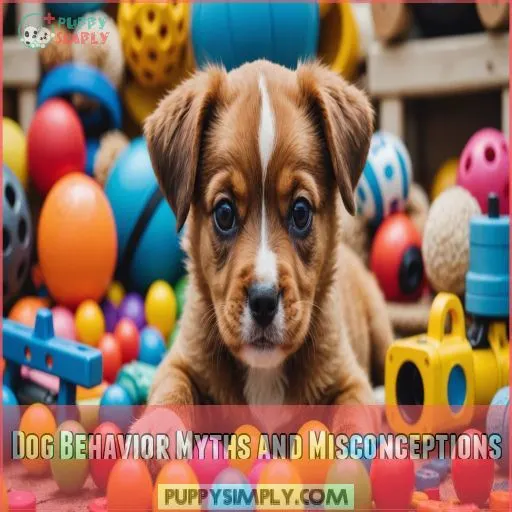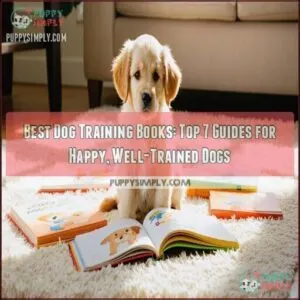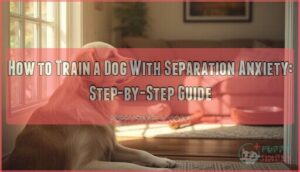This site is supported by our readers. We may earn a commission, at no cost to you, if you purchase through links.

Prefer a peek into the canine mind? "The Genius of Dogs" will satisfy your curiosity about dog intelligence. These books turn every wag, woof, and wiggle into teachable moments, giving you control and understanding while transforming your pet into a well-behaved companion. Ready to explore your dog’s full potential?
Table Of Contents
- Key Takeaways
- Essential Dog Training Books
- Positive Reinforcement Training
- Building Confidence and Focus
- Managing Prey Drive and Resource Guarding
- Dog Communication and Calming Signals
- Dog Training Methods and Effectiveness
- Dog Behavior Myths and Misconceptions
- Getting Started With Dog Training
- Frequently Asked Questions (FAQs)
- What books to read to become a dog trainer?
- What is the first thing you should teach your dog?
- What is the number one rule in dog training?
- What is the best order to train a dog?
- What are the basic commands every dog should know?
- How do I choose the right training method for my dog?
- How can I teach my dog advanced tricks and skills?
- What are the signs of an aggressive or fearful dog?
- How do I start a successful dog training business?
- Conclusion
Key Takeaways
- Start with positive reinforcement techniques; it’s like giving your dog a gold star for every trick. You’ll be amazed at how quickly they respond to treats and affection instead of outdated disciplinary measures.
- Dive into some must-read books—like "The Power of Positive Dog Training" and "Don’t Shoot the Dog!"—that’ll make you feel like you’ve got a personal dog whisperer in your living room.
- Keep your high-energy pup zen with daily exercise and mental games. Picture it as a gym for their brain; after burning off all that energy, they’ll trade chaos for calmness.
- Understand canine body language like a pro, turning tail wags and yawns into a secret language that helps you communicate better by understanding potential aggression triggers. It’s like adding a whole new tool to your dog-owning toolkit!
Essential Dog Training Books
If you’ve ever felt your dog’s ignoring you like they’re the boss, a good training book might be your secret weapon.
We’ve rounded up essential reads that’ll have your pup wagging their tail for every command faster than you can say "sit!
Positive Reinforcement Books for Beginners
Getting your puppy to behave might feel like trying to catch a cloud with your hands! But don’t worry; there’s a better way. Get into dog training for beginners with positive reinforcement and discover techniques like clicker training and shaping.
- "Don’t Shoot the Dog!" by Karen Pryor: This is a gem for learning clicker training and reward systems. It’s like having a wise friend whispering dog secrets!
- "The Power of Positive Dog Training": Offers practical puppy training with a playful twist involving games using positive reinforcement techniques.
- "How to Behave So Your Dog Behaves": Simplifies training with empathy and clear steps.
- "Inside of a Dog": Gets into your dog’s mind, making training a fun adventure.
These books make puppy training a walk in the park!
Positive Reinforcement Training
Positive reinforcement training is the way to go if you want a well-behaved, happy pup.
By rewarding good behaviors, you’ll build a strong bond and teach your dog the right way to act – no need for outdated punishment methods here.
Benefits of Reward-Based Training
In dog training, reward-based methods offer stress-free training and a stronger bond with your dog. You’ll see positive results and reduced aggression. Enjoy fun learning!
| Benefit | Description | Impact on Dog |
|---|---|---|
| Stress-Free | Reduces anxiety | Happier dog |
| Stronger Bond | Encourages connection | Better relationship |
| Fun Learning | Makes training enjoyable | Engages both |
| Positive Results | Encourages good behavior | More obedient pet |
| Reduced Aggression | Lessens negative behavior | Calmer interactions |
Effective Techniques for Positive Reinforcement
To reinforce good behavior, use clicker training and treat motivation. Think of it like shaping a dog’s skills with patience and practice.
Scientific Studies on Dog Intelligence
Peeking into dog cognition reveals a treasure chest of insights! Canine communication shows amazing breed differences, learning styles, and problem-solving skills in dog training.
Dog Emotions and Behavior
Get to know your pup’s inner world. Explore the rich emotional landscape that shapes their behavior and forge a deeper bond.
Recommended Books for Dog Behaviorists
For an enlightening read on dog behavior, check out "The Genius of Dogs." You’ll find fascinating insights into canine psychology and ethical, science-based methods.
Building Confidence and Focus
If your dog acts like they have a coffee addiction, bouncing off the walls and unable to focus, you’re not alone.
Discover how to channel that energy into building confidence and impulse control using specific techniques and top-recommended books.
Key Principles for High-Energy Dogs
If your high-energy dog’s bouncing off the walls, focus on these principles:
- Exercise daily – Not just a walk, think marathons.
- Mental stimulation – Puzzle toys or hide-and-seek work wonders.
- Consistency in training – Keeps chaos in check.
These dog training tips will transform your whirlwind into a champion!
Effective Training Methods for Impulse Control
Boost your dog’s focus with fun impulse control exercises like "leave it" and "wait."
Teach them to stay calm amid distractions through positive reinforcement and calming games.
Consistency is key for building that unbreakable bond.
Recommended Books for Building Confidence
When Fido’s bouncing off the walls with energy, teaching impulse control is key!
"Control Unleashed" by Leslie McDevitt is an excellent dog training manual for building confidence in reactive or anxious dogs.
Discover techniques to turn your whirlwind into a zen master!
Managing Prey Drive and Resource Guarding
When your furry friend sees squirrels as workout partners or guards toys like they’re gold, you’ll need a game plan.
Let’s explore expert tricks to channel that prey drive and manage resource guarding, keeping the peace at home and the doggy drama minimal.
Strategies for Managing Prey Drive
Shifting gears from building confidence, managing your dog’s prey drive might feel like herding cats.
Recognize prey drive triggers and redirect behavior using safe play and leash training.
Address exercise needs for freedom without turning your house into a canine racetrack!
Effective Techniques for Resource Guarding
If your pup’s a resource guarder, don’t fret! Try counterconditioning, desensitization, and management strategies to curb this behavior. With patience and the right techniques, you can help your canine pal feel secure and comfortable sharing their treasures.
- Reward-based counterconditioning to change the dog’s emotional response
- Gradual desensitization to build tolerance for sharing resources
- Proactive management, like using food puzzles or separate feeding areas
Recommended Books for Managing Prey Drive and Resource Guarding
Two must-reads for tackling your pup’s prey drive and resource guarding are "Hunting Together" and "Mine!"
These dog training books offer proven training techniques and behavior modification strategies to help manage littermate syndrome.
Check out these insightful gems to transform dog safety!
| Book Title | Author (s) | Price |
|---|---|---|
| Hunting Together | Ken M. Martin & Debbie Martin | $18.79 |
| Mine! | Jean Donaldson | $4.69 |
Dog Communication and Calming Signals
To truly understand your dog, you’ve got to learn their language, which often means translating tails wags and little lip licks.
These subtle signals can prevent misunderstandings, just like avoiding eye contact with an ex in the supermarket aisle!
Understanding Canine Body Language
Understanding canine body language is like learning a new language.
It’s all about the tail wags, ears, and posture.
Watch for:
- Lip licking
- Yawning
- Relaxed tail
- Play bows
These clues help decode your dog’s feelings and intentions.
Effective Techniques for Calming Signals
Curious about calming signals? Observe your pup’s body language – yawning, lip licking, and turning away can indicate stress.
Try these soothing techniques: slow blinks, gentle petting, and providing a safe space.
Mastering canine communication is key for a happy, healthy bond.
| Calming Signal | Meaning |
|---|---|
| Yawning | Stress/Anxiety |
| Lip Licking | Discomfort |
| Turning Away | Avoidance |
Recommended Books for Dog Communication
Ready to understand your pup’s mind? These books are your trusty companions. They’ll help you understand the secrets of dog communication, making you the Sherlock Holmes of canine body language:
- On Talking Terms With Dogs
- The Other End of the Leash
- The Power of Positive Dog Training
Dog Training Methods and Effectiveness
When you’re starting to train your dog, figuring out all the training methods out there might feel like choosing the right flavor at an ice cream shop—overwhelming yet important.
Understanding how different techniques work, especially the power of positive reinforcement, can make all the difference in raising a well-behaved pup while having a blast doing it.
Research on Training Methods
When communicating with dogs, understanding body language is just the tip of the iceberg.
Training methods impact behavior.
Let’s jump into the deep end, exploring the research on training methods.
Learn how dog training methods impact behavior using scientific evidence from top dog training books, like those that explain understanding aggression triggers.
Effectiveness of Positive Reinforcement
Positive reinforcement is the most effective training method, hands down.
Clicker training and shaping behavior with rewards will bring out the best in your pup.
Trust the science – dogs thrive on this approach.
Comparison of Different Training Methods
You’re probably thinking, “Which training style works best?” Let’s break it down.
- Traditional vs. modern: Science-based methods shift toward kindness.
- Consistency is key; dogs thrive on steady cues.
- Punishment vs. reward: Choose rewards for happier, well-behaved pups!
Dog Behavior Myths and Misconceptions
Unraveling the truth behind dog behavior myths can make all the difference in your training journey.
Let’s debunk the outdated dominance theory that’s about as relevant today as dial-up internet!
Debunking Dominance Theory
Imagine your pup as a partner, not a pawn.
Gone are the days of barking orders!
Modern training tosses the dominance theory aside.
Embrace dog-pack dynamics, inspired by wolf behavior, for a respectful approach.
Discover positive alternatives in great dog training books.
Misconceptions About Dog Behavior
Shedding light on common dog behavior myths can empower owners.
Dominance theory, alpha wolves, and pack hierarchies are outdated concepts.
Understanding canine communication and psychology is key to building a fulfilling bond with your pup.
Recommended Books for Correcting Misconceptions
If you’re looking to debunk dog behavior myths, grab "The Misbehavior of Organisms" and "Why Won’t Dominance Die?"
These dog training books use humor and research to challenge the alpha wolf myth and dominance theory, making dog training misconceptions crystal clear.
Getting Started With Dog Training
Getting started with dog training can feel like you’re trying to teach an old dog new tricks, but with the right resources, it’s a walk in the park. Check out these training tips.
We’ve rounded up the best books that will guide you through the basics, ensuring a happy and well-behaved pup.
Essential Steps for Beginners
Starting dog training can feel like wrangling a whirlwind, but it’s all about setting realistic goals and choosing the right trainer.
Master basic obedience commands, understand puppy socialization, and gather equipment essentials for a fun, successful journey.
Ready?
Recommended Books for New Dog Trainers
Discover a wealth of training books to kickstart your journey – from clicker training guides to behavior science tomes. Pair these with a seasoned mentor for the ultimate dog-owning success!
Tips for Successful Dog Training
Nail dog training success by consistently showing up like a committed dog-lover. Believe in patience; it’s golden.
Set achievable training goals.
Clear communication and positive reinforcement are key.
Check out dog training books, and you’ll become your own dog training consultant!
Frequently Asked Questions (FAQs)
What books to read to become a dog trainer?
You’ll get a leg up on becoming a dog trainer by reading "So You Want to Be a Dog Trainer" and "Handbook of Dog Behavior and Training V1-" Training and Socialization is a crucial part of owning a Jack Russell Terrier
They provide essential knowledge and business savvy—tailor-made for your journey!
What is the first thing you should teach your dog?
What’s the first thing your dog should learn?
Teaching your dog their name is really important.
It’s like giving them a VIP pass to your world.
It opens doors to communication, making them more obedient and attentive.
What is the number one rule in dog training?
The golden rule of dog training is consistency—like maintaining a good rhythm in a dance.
Stick to clear commands and reinforce behaviors consistently.
Dogs thrive on predictability, turning chaos into harmony, letting you lead the way.
What is the best order to train a dog?
Pup’s progress peaks with a patient, positive plan. Prioritize pup’s primal needs, perfect polite paw-shakes, and practice playtime. Persevere, pup, and your peerless pup will proudly prance through life’s paces.
What are the basic commands every dog should know?
Teaching your dog basic commands is like giving them a language to understand you: sit, stay, come, down, and leave it.
Nail these, and you’ll both speak the same language—no interpreter required!
How do I choose the right training method for my dog?
Choosing the right training method is like tailoring a suit—consider your dog’s personality, needs, and your own style.
Positive reinforcement; it’s like giving a treasure map instead of rules—rewarding for everyone!
How can I teach my dog advanced tricks and skills?
Actions speak louder than words!
Start small, using positive reinforcement and clicker training.
Break complex tricks into bite-sized steps.
Remember, patience is key.
Celebrate every success, and you’ll discover your dog’s hidden talents in no time!
What are the signs of an aggressive or fearful dog?
If your dog’s ears are back, they’re avoiding eye contact, or they’re growling, these could be signs of aggression or fear.
Stay calm, avoid direct confrontation, and consult a professional trainer for guidance on addressing these behaviors safely.
How do I start a successful dog training business?
So, you’re diving into the dog training game!
Harness your passion.
Craft a solid business plan.
Build rapport with clients and dogs.
Don’t put all your eggs in one basket—diversify services for success.
Conclusion
Think of your dog training journey as planting a garden.
With the best dog training books for beginners, you’re sowing the seeds of trust and harmony between you and your pup.
Each wagging tail and excited bark is a sign of your efforts.
Embrace positive reinforcement, tackle behavioral quirks, and deepen your understanding of canine communication.
Remember, every great gardener knows patience and persistence bloom into rewarding relationships.
Enjoy nurturing your four-legged friend into a well-behaved companion!



